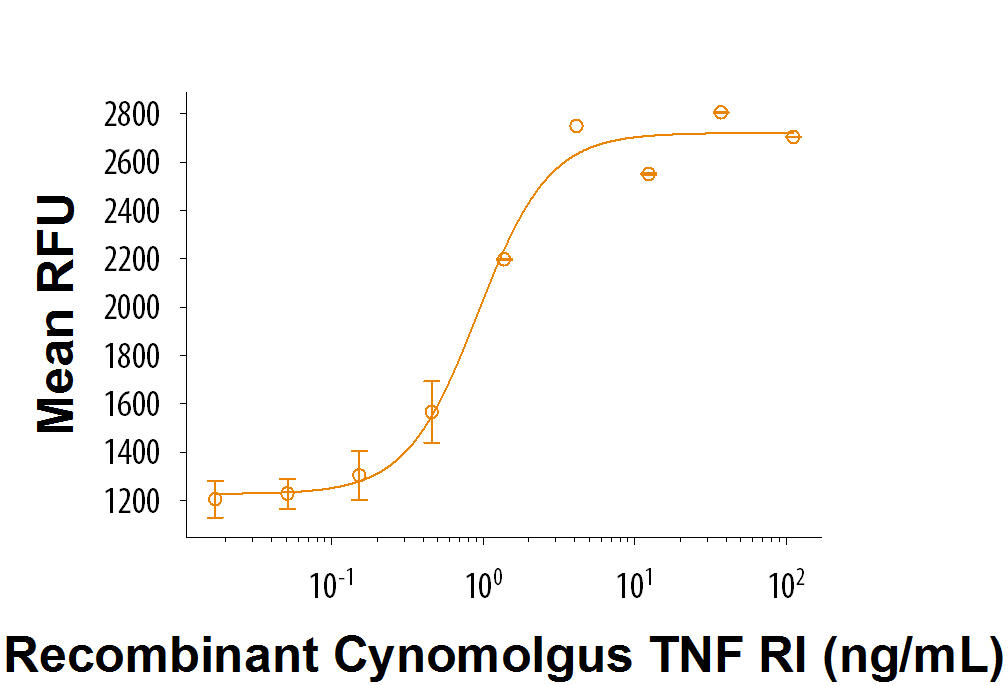Recombinant Cynomolgus TNF RI/TNFRSF1A Fc Protein, CF
Recombinant Cynomolgus TNF RI/TNFRSF1A Fc Protein, CF Summary
Product Specifications
| Cynomolgus Monkey TNF RI/TNFRSF1A (Leu30-Thr211) Accession # NP_001306550 | IEGRMD | Human IgG1 (Pro100-Lys330) |
| N-terminus | C-terminus | |
Analysis
Product Datasheets
Carrier Free
CF stands for Carrier Free (CF). We typically add Bovine Serum Albumin (BSA) as a carrier protein to our recombinant proteins. Adding a carrier protein enhances protein stability, increases shelf-life, and allows the recombinant protein to be stored at a more dilute concentration. The carrier free version does not contain BSA.
In general, we advise purchasing the recombinant protein with BSA for use in cell or tissue culture, or as an ELISA standard. In contrast, the carrier free protein is recommended for applications, in which the presence of BSA could interfere.
9884-TR
| Formulation | Lyophilized from a 0.2 μm filtered solution in PBS. |
| Reconstitution | Reconstitute at 500 μg/mL in PBS. |
| Shipping | The product is shipped at ambient temperature. Upon receipt, store it immediately at the temperature recommended below. |
| Stability & Storage: |
|
Scientific Data
 View Larger
View Larger
Recombinant Cynomolgus Monkey TNF RI/TNFRSF1A Fc Chimera (Catalog # 9884-TR) inhibits Recombinant Human TNF-a (Catalog # 210-TA) mediated cytotoxicity in the L-929 mouse fibroblast cells. The ED50 for this effect is 0.6-3.6 ng/mL.
 View Larger
View Larger
2 μg/lane of Recombinant Cynomolgus Monkey TNF RI/TNFRSF1A was resolved with SDS-PAGE under reducing (R) and non-reducing (NR) conditions and visualized by Coomassie® Blue staining, showing bands at 55-66 kDa and 110-130 kDa, respectively.
Reconstitution Calculator
Background: TNF RI/TNFRSF1A
TNF receptor 1 is a 55 kDa type I transmembrane protein member of the TNF receptor superfamily, designated TNFRSF1A (1, 2). TNF RI is a 455 amino acid (aa) protein that contains a signal sequence and ECD with a PLAD (pre-ligand assembly domain) that mediates constitutive dimer/trimer formation, followed by four CRD (cysteine-rich domains), a transmembrane domain, and a cytoplasmic domain that contains a neutral sphingomyelinase activation domain and a death domain (3, 4). The ECD of cynomolgus TNF RI shows 97%, 69%, and 68% aa identity with human, mouse and rat TNF RI, respectively. Both TNF RI and TNF RII (TNFRSF1B) are widely expressed and contain four TNF-alpha trimer-binding CRD in their ECD. However, TNF RI is thought to mediate most of the cellular effects of TNF-alpha (3). TNF RI is essential for proper development of lymph node germinal centers and Peyer's patches, and for combating intracellular pathogens such as Listeria (1, 2, 5). TNF RI is also a receptor for TNF-beta/TNFSF1B (lymphotoxin-alpha) (6). TNF RI is stored in the Golgi and translocates to the cell surface following pro‑inflammatory stimuli (7). TNF-alpha stabilizes TNF RI and induces its sequestering in lipid rafts, where it activates NF kappa B and is cleaved by ADAM-17/TACE (8, 9, 16). Release of the 28-34 kDa TNF RI ECD also occurs constitutively and in response to products of pathogens such as LPS, CpG DNA or S. aureus protein A (1, 10-12). Full-length TNF RI may also be released in exosome-like vesicles (13). Release helps to resolve inflammatory reactions, since it down-regulates cell surface TNF RI and provides soluble TNF RI to bind TNF-alpha (10, 14-15). Exclusion from lipid rafts causes endocytosis of TNF RI complexes and induces apoptosis (1). Mutations of human TNF R1 can result in inflammatory episodes known as TRAPS (TNFR-associated periodic syndrome) (7).
- Pfeffer, K. (2003) Cytokine Growth Factor Rev. 14:185.
- Hehlgans, T. and K. Pfeffer (2005) Immunology 115:1.
- Chan, F.K. et al. (2000) Science 288:2351.
- Schall, T.J. et al. (1990) Cell 61:361.
- Peschon, J.J. et al. (1998) J. Immunol. 160:943.
- Banner, D.W et al. (1993) Cell 73:431.
- Turner, M.D. et al. (2012) Biosci. Rep. 32:105.
- Legler, D.F. et al. (2003) Immunity 18:655.
- Tellier, E. et al. (2006) Exp. Cell Res. 312:3969.
- Xanthoulea, S. et al. (2004) J. Exp. Med. 200:367.
- Jin, L. et al. (2000) J. Immunol. 165:5153.
- Gomez, M.I. et al. (2006) J. Biol. Chem. 281:20190.
- Islam, A. et al. (2006) J. Biol. Chem. 281:6860.
- Garton, K.J. et al. (2006) J. Leukoc. Biol. 79:1105.
- McDermott, M.F. et al. (1999) Cell 97:133.
FAQs
No product specific FAQs exist for this product, however you may
View all Proteins and Enzyme FAQsReviews for Recombinant Cynomolgus TNF RI/TNFRSF1A Fc Protein, CF
There are currently no reviews for this product. Be the first to review Recombinant Cynomolgus TNF RI/TNFRSF1A Fc Protein, CF and earn rewards!
Have you used Recombinant Cynomolgus TNF RI/TNFRSF1A Fc Protein, CF?
Submit a review and receive an Amazon gift card.
$25/€18/£15/$25CAN/¥75 Yuan/¥1250 Yen for a review with an image
$10/€7/£6/$10 CAD/¥70 Yuan/¥1110 Yen for a review without an image




